
The Governor's Palace is the city hall of Asmara, Eritrea. It was built during the colonial period in the city centre, in an Italian Art Deco style. [1]

The Governor's Palace is the city hall of Asmara, Eritrea. It was built during the colonial period in the city centre, in an Italian Art Deco style. [1]
The former Italian government's palace was built in 1897 by Ferdinando Martini, the first Italian governor of Eritrea (now it is the Asmara President's Office). The Gibi, as it is known, was converted into the Museum of Asmara during the Ethiopian administration, when the Governor's Palace was moved to its present building.
The current city hall was built during the 1930s in typical Fascist style (called Littorio), with a central tower at the entrance adorned with "Fasci" (destroyed in March 1941, when the city was conquered by the British). It is located next to the Court House and the Ministry of Justice of the Republic of Eritrea, in the central section of Asmara that has been named a World Heritage Site by the UNESCO in 2017. [2]

The Asmara City Hall appeared on Asmara's last revenue stamps, which were issued in 1960.

Eritrea is an ancient name, associated in the past with its Greek form Erythraia, Ἐρυθραία, and its derived Latin form Erythræa. This name relates to that of the Red Sea, then called the Erythræan Sea, from the Greek for "red", ἐρυθρός, erythros. But earlier Eritrea was called Mdre Bahri. The Italians created the colony of Eritrea in the 19th century around Asmara and named it with its current name. After World War II, Eritrea annexed to Ethiopia. Following the communist Ethiopian government's defeat in 1991 by the coalition created by various armed groups notably the EPLF and the TPLF among others, Eritrea declared its independence. Eritrea officially celebrated its 1st anniversary of independence on May 24,1993.

Asmara, or Asmera, is the capital and most populous city of Eritrea, in the country's Central Region. It sits at an elevation of 2,325 metres (7,628 ft), making it the sixth highest capital in the world by altitude and the second highest capital in Africa. The city is located at the tip of an escarpment that is both the northwestern edge of the Eritrean Highlands and the Great Rift Valley in neighbouring Ethiopia. In 2017, the city was declared as a UNESCO World Heritage Site for its well-preserved modernist architecture. According to local traditions, the city was founded after four separate villages unified to live together peacefully after long periods of conflict. Asmara had long been overshadowed by nearby Debarwa, the residence of the Bahr Negash or the governor of the coastal province, however it still existed as a major settlement for over half a millennium and enjoyed some importance as it stood on the trade route to Massawa. Asmara first rose to prominence during the 20th century, when it became capital of Italian Eritrea. Under Italian rule the city of Asmara experienced rapid urbanization and modernization.
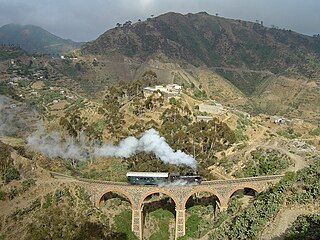
The Eritrean Railway is the only railway system in Eritrea. It was constructed between 1887 and 1932 during the Italian Eritrea colony and connects the port of Massawa with Asmara. Originally it also connected to Bishia. The line was partly damaged by warfare in subsequent decades, but was rebuilt in the 1990s. Vintage equipment is still used on the line.

Massawa or Mitsiwa is a port city in the Northern Red Sea region of Eritrea, located on the Red Sea at the northern end of the Gulf of Zula beside the Dahlak Archipelago. It has been a historically important port for many centuries. Massawa has been ruled or occupied by a succession of polities during its history, including the Kingdom of Aksum, the Ethiopian Empire, the Ottoman Empire and the Kingdom of Italy.
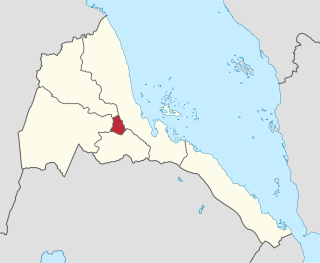
Central Region, also known as the Ma'ekel or Maakel Region, is an administrative region of Eritrea, located in central Eritrea. The region was formed on 15 April 1996, from the historical province of Hamasien. The region is located on the central plateau, and sits at an average of about 2,250 metres (7,380 ft) above sea level. It contains Asmara, the capital and largest city of Eritrea.

The Fiat Tagliero Building is a Futurist-style service station in Asmara, Eritrea. It was completed in 1938 and designed by the Italian engineer Giuseppe Pettazzi.

The Cinema Impero is an Art Deco-style cinema in Asmara, the capital of Eritrea. It was built in 1937 by the colonial authorities in Italian Eritrea.

The Church of Our Lady of the Rosary, Asmara is a Catholic church built in the early 1920s in Asmara, when the city was the capital of Italian Eritrea. Often called "the cathedral", it is a large Lombard Romanesque style church in the centre of the city, built in 1923 to serve as the principal church of the Apostolic Vicariate of Eritrea.
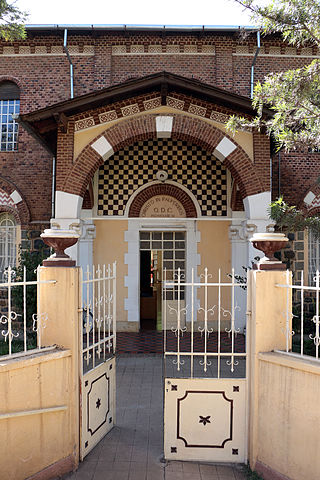
The National Museum of Eritrea is a national museum in Asmara, Eritrea. Established in 1992 by Woldeab Woldemariam, it was originally located in the former Governor's Palace until 1997, when it was moved. The venue has since been relocated to the former Comboni Sisters School for Women.
Articles related to Eritrea include:

Eritrea, officially the State of Eritrea, is a country in the Horn of Africa region of Eastern Africa, with its capital and largest city at Asmara. It is bordered by Ethiopia in the south, Sudan in the west, and Djibouti in the southeast. The northeastern and eastern parts of Eritrea have an extensive coastline along the Red Sea. The nation has a total area of approximately 117,600 km2 (45,406 sq mi), and includes the Dahlak Archipelago and several of the Hanish Islands.

Italian Eritreans are Eritrean-born citizens who are fully or partially of Italian descent, whose ancestors were Italians who emigrated to Eritrea during the Italian diaspora, or Italian-born people in Eritrea.

The Asmara President's Office is the building, in Italian neoclassical style, where the President of Eritrea lives and rules the country.

Italian Eritrea was a colony of the Kingdom of Italy in the territory of present-day Eritrea. The first Italian establishment in the area was the purchase of Assab by the Rubattino Shipping Company in 1869, which came under government control in 1882. Occupation of Massawa in 1885 and the subsequent expansion of territory would gradually engulf the region and in 1889 the Ethiopian Empire recognized the Italian possession in the Treaty of Wuchale. In 1890 the Colony of Eritrea was officially founded.

The Summer Palace of Peter the Great was built in Saint Petersburg between 1710 and 1714 in the northeast corner of the Summer Garden, located on an island formed by the Fontanka River, Moyka River, and the Swan Canal. Its northern perimeter runs along the left bank of the Neva River across from the Cabin of Peter the Great and Peter and Paul Fortress and was the first palace built in Saint Petersburg, the second largest city in Russia.
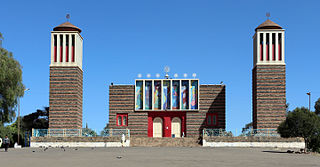
Enda Mariam Cathedral is an Eritrean Orthodox church in Asmara, Eritrea. The cathedral is located on Arbate Asmara Street.

Asmara, the capital of Eritrea, first rose to prominence in medieval and post-medieval times. Though it had long overshadowed by nearby Debarwa, the residence of the Bahr Negash or the governor of the coastal province, it still existed as a major settlement for over half a millennium and enjoyed some importance as it stood on the trade route to Massawa. During the 20th century it was a staging ground for Italian initiatives in East Africa, collateral of Britain's colonial politics, and the subject of the expansion of Ethiopia until 1993, when the sovereign state of Eritrea was established. Despite the passage of over seventy years, the city has remained mostly unchanged in structural design, likely influenced by its position as a UNESCO World Heritage Site.
The following is a timeline of the history of the city of Asmara, Eritrea. Asmara was under Italian colonial rule from 1889 until 1941.
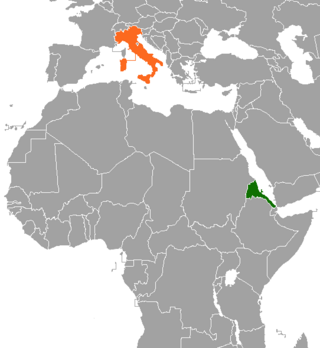
Eritrea–Italy relations are the bilateral relations between Italy and Eritrea. Both nations are members of the United Nations.

Bar Zilli is a building located in central Asmara, Eritrea. Currently, it operates as a restaurant and it serves as a commonly identifiable landmark to Asmara residents.